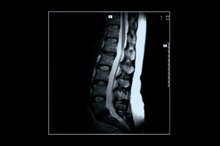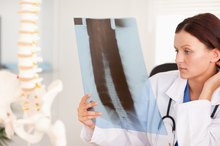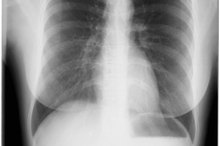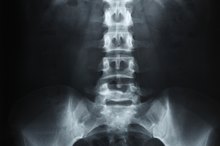What does fact checked mean?
At Healthfully, we strive to deliver objective content that is accurate and up-to-date. Our team periodically reviews articles in order to ensure content quality. The sources cited below consist of evidence from peer-reviewed journals, prominent medical organizations, academic associations, and government data.
- "Journal of Spinal Cord Medicine": Late Complications of Displaced Thoracolumbar Fusion Instrumentation; Kazuko Shem M.D.
- "Journal of Spinal Cord Medicine": Late Complications of Displaced Thoracolumbar Fusion Instrumentation; Kazuko Shem M.D.
The information contained on this site is for informational purposes only, and should not be used as a substitute for the advice of a professional health care provider. Please check with the appropriate physician regarding health questions and concerns. Although we strive to deliver accurate and up-to-date information, no guarantee to that effect is made.
Complications of Spinal Fusion With Harrington Rods
Scoliosis, or curvature of the spine, affects 2 to 3 percent of the population in the United States, or about 6 million people, the A.D.A.M. Medical Encyclopedia reported in 2009 2. Scoliosis most often appears between ages 10 and 15 and affects about 10 percent of all adolescents, although only about 1 percent require treatment. Between 1964 and 2000, the standard treatment for scoliosis was fusion of the vertebrae in the curved part of the spine and placement of a steel rod, called a Harrington rod, which attached to the vertebrae to allow the fused spine to heal. Complications can occur after Harrington rod placement.
Flat-Back Syndrome
Normally, the lower part of the spine, called the lumbar spine, curves inward, a condition known as lordosis. Placement of a Harrington rod that extends to the lower spine can cause flat-back syndrome, in which the lumbar spine no longer curves inward but flattens or even bulges outward, a condition called lumbar kyphosis. About 40 percent of patients with Harrington rods develop flat-back syndrome, A.D.A.M. reports. Symptoms include back pain and an inability to stand up straight. People with flat-back syndrome may lean forward or lose hip flexibility. Surgery to repair flat-back syndrome is complex and symptoms may persist after surgery. Not placing rods in the lumbar spine and using segmented devices rather than a single rod has reduced the incidence in recent years, the National Scoliosis Foundation states 1.
- Normally, the lower part of the spine, called the lumbar spine, curves inward, a condition known as lordosis.
- Placement of a Harrington rod that extends to the lower spine can cause flat-back syndrome, in which the lumbar spine no longer curves inward but flattens or even bulges outward, a condition called lumbar kyphosis.
Crankshaft Phenomenon
Symptoms of Lumbar Hemangioma
Learn More
Crankshaft phenomenon occurs in 33 percent of children who had Harrington rods placed when they were younger than 11 and still had immature skeletons, lead author Dr. Kimberly Kesling, of the Twin Cities Spine Center in Minneapolis, reported at the 2001 Scoliosis Research Society meeting. The front part of the spine continues to grow normally while the fused posterior spine doesn’t grow. The posterior spine becomes twisted and curves as the anterior portion grows. Fusing both the front and back spine in young children helps prevent crankshaft phenomenon.
- Crankshaft phenomenon occurs in 33 percent of children who had Harrington rods placed when they were younger than 11 and still had immature skeletons, lead author Dr. Kimberly Kesling, of the Twin Cities Spine Center in Minneapolis, reported at the 2001 Scoliosis Research Society meeting.
- The posterior spine becomes twisted and curves as the anterior portion grows.
Hardware Migration
Harrington rods are metal rods attached to bone with hooks and other metal devices. Rods can break; hooks and other metal pieces can migrate to other areas of the spine, causing nerve damage, back pain and, in the case of severe symptoms, lead to surgery to remove the damaged parts, Dr. Kazuko Shem, of the Santa Clara Valley Medical Center in San Jose, Calif., reported in the 2005 "Journal of Spinal Cord Medicine."
Infection
Complications of Lumbar Laminectomy
Learn More
Infection can occur after placement of a Harrington rod. Inflammation can occur as a reaction to a foreign body in the spine, the Encyclopedia of Surgery reports 4.
Related Articles
References
- National Scoliosis Foundation: Flat-Back
- A.D.A.M. Medical Ilustrated Encyclopedia: Scoliosis
- "Journal of Spinal Cord Medicine": Late Complications of Displaced Thoracolumbar Fusion Instrumentation; Kazuko Shem M.D.
- Encyclopedia of Surgery: Spinal Instrumentation
- American Association of Neurological Surgeons. Scoliosis
- Horne JP, Flannery R, Usman S. Adolescent idiopathic scoliosis: diagnosis and management. Am Fam Physician. 2014;89(3):193-8.
- Boston Childlren's Hospital. Congenital Scoliosis
- American Academy of Orthopaedic Surgeons. OrthoInfo. Neuromuscular Scoliosis
- Weill Cornell Medicine. Center for Comprehensive Spine Care. Scoliosis: Symptoms, Types & Treatments
- Wang J, Zhang J, Xu R, Chen TG, Zhou KS, Zhang HH. Measurement of scoliosis Cobb angle by end vertebra tilt angle method. J Orthop Surg Res. 2018;13(1):223. doi:10.1186/s13018-018-0928-5
- Karimi MT, Rabczuk T. Scoliosis conservative treatment: A review of literature. J Craniovertebr Junction Spine. 2018;9(1):3-8. doi:10.4103/jcvjs.JCVJS_39_17
- American Association of Neurological Surgeons. (2019). Scoliosis.
- Children's Hospital of Philadelphia. (2019). Congenital Scoliosis.
- Dewan MC, Mummareddy N, Bonfield C. The influence of pregnancy on women with adolescent idiopathic scoliosis. Eur Spine J. 2018 Feb;27(2):253-63. doi:10.1007/s00586-017-5203-7
- Hey LA. (2018). Scoliosis in the adult. Atlas SJ, ed. UpToDate. Waltham, MA: UpToDate Inc.
- Horne JP, Flannery R, Usman S. Adolescent Idiopathic Scoliosis: Diagnosis and Management. Am Fam Physician. 2014 Feb 1;89(3):193-98.
- Scoliosis Research Society. (2019). Scoliosis.
Writer Bio
A registered nurse with more than 25 years of experience in oncology, labor/delivery, neonatal intensive care, infertility and ophthalmology, Sharon Perkins has also coauthored and edited numerous health books for the Wiley "Dummies" series. Perkins also has extensive experience working in home health with medically fragile pediatric patients.









